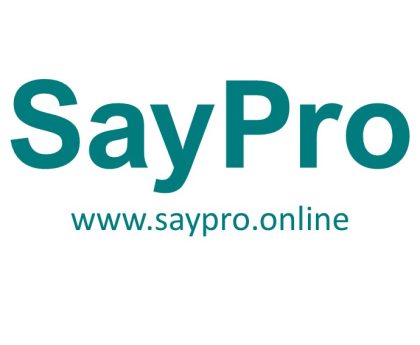SayPro Tasks to Be Done for the Period Implement Enhanced Security Features Ensure that user data is protected in compliance with data protection laws and industry standards from SayPro Monthly January SCMR-17 SayPro Quarterly User Accounts by SayPro Online Marketplace Office under SayPro Marketing Royalty SCMR
Overview: During this period, SayPro will focus on implementing enhanced security measures that ensure the protection of user data and comply with relevant data protection laws and industry standards. The tasks will include strengthening security protocols, enhancing data encryption methods, and ensuring that user privacy is safeguarded according to legal requirements such as GDPR (General Data Protection Regulation) and CCPA (California Consumer Privacy Act).
Key Tasks for Implementing Enhanced Security Features:
1. Conduct a Security Assessment for Data Protection Laws Compliance:
- Objective: Ensure that all security features are in line with relevant data protection laws (GDPR, CCPA, etc.) and industry standards.
- Action Plan:
- Identify Relevant Legal Requirements:
- Review the latest data protection regulations such as GDPR (for EU users) and CCPA (for California residents), identifying the obligations that apply to SayPro’s user account management system.
- Assess Data Handling Practices:
- Evaluate how user data is collected, stored, processed, and shared on the platform, ensuring that it aligns with legal standards for user consent, data minimization, and user access rights.
- Data Protection Impact Assessment (DPIA):
- Perform a DPIA to assess the potential risks to user privacy and data protection related to the account management system. Develop strategies for mitigating any identified risks.
- Identify Relevant Legal Requirements:
- Expected Outcomes:
- Compliance with data protection laws, ensuring that user privacy is respected and legal obligations are met.
- Identification of areas where SayPro can improve its data handling and user privacy practices.
2. Implement Advanced Encryption Standards:
- Objective: Secure all sensitive user data in transit and at rest, ensuring that it is protected from unauthorized access.
- Action Plan:
- Encrypt Data in Transit:
- Ensure all user data exchanged between the platform and its users is transmitted securely using HTTPS (SSL/TLS) to prevent interception during transmission.
- Encrypt Data at Rest:
- Review and implement encryption standards such as AES (Advanced Encryption Standard) for storing sensitive information (e.g., passwords, personal details, payment information) on servers. Ensure encryption keys are managed securely.
- Update Encryption Protocols:
- Regularly review and update encryption protocols to ensure they remain effective and in compliance with the latest security standards.
- Encrypt Data in Transit:
- Expected Outcomes:
- Enhanced protection of user data against data breaches, ensuring that even if data is compromised, it remains unreadable without proper decryption keys.
- Strengthened compliance with data protection regulations, which mandate encryption as a key component of user privacy.
3. Strengthen User Authentication and Access Controls:
- Objective: Enhance security for user logins and account management to prevent unauthorized access and account breaches.
- Action Plan:
- Implement Multi-Factor Authentication (MFA):
- Integrate multi-factor authentication (MFA) to add an additional layer of security. Users will be required to provide two or more forms of verification (e.g., password and a one-time code sent to their phone or email).
- Enforce Strong Password Policies:
- Require users to set strong passwords that meet specific criteria (e.g., length, complexity) and enforce periodic password changes. Educate users on how to create secure passwords.
- Account Lockout Mechanism:
- Implement mechanisms to lock user accounts after a certain number of failed login attempts to protect against brute-force attacks.
- Session Management:
- Ensure that user sessions are securely managed, with automatic logouts after periods of inactivity to prevent unauthorized access in case of session hijacking.
- Implement Multi-Factor Authentication (MFA):
- Expected Outcomes:
- Reduction in the risk of unauthorized access due to weak or compromised user credentials.
- Increased trust and satisfaction among users, knowing their accounts are protected by robust security measures.
4. Regularly Update Privacy Policies and Terms of Service:
- Objective: Ensure that privacy policies and terms of service are up-to-date with the latest regulations and security practices.
- Action Plan:
- Review and Update Policies:
- Regularly review SayPro’s privacy policy and terms of service to ensure they reflect the latest data protection laws and best practices for security. Specifically, update the terms related to data processing, user rights, and security measures.
- Transparency on Data Usage:
- Clearly outline how user data is collected, processed, and used, ensuring that users are fully informed about how their personal information is being handled.
- Consent Management:
- Update the platform to ensure that users can easily manage their consent preferences for data processing, including options to opt-in or opt-out of data sharing and marketing communications.
- Review and Update Policies:
- Expected Outcomes:
- Users will be fully informed of how their data is handled, enhancing transparency and compliance with regulations.
- Improved user trust due to clear and updated policies regarding privacy and security practices.
5. Enhance User Data Recovery Processes:
- Objective: Ensure that user data can be securely recovered in the event of account loss or unauthorized access while protecting against data breaches during recovery.
- Action Plan:
- Secure Account Recovery Procedures:
- Implement secure account recovery processes, including identity verification steps, to ensure that only legitimate users can regain access to their accounts.
- Utilize Strong Recovery Tokens:
- When sending password recovery links or tokens, ensure they are one-time-use and expire after a set time (e.g., 24 hours). These tokens should also be encrypted to prevent interception.
- Verification via Multiple Channels:
- Offer recovery options through multiple channels, such as email, SMS, and phone calls, but ensure these channels are secured (e.g., SMS should be encrypted).
- Secure Account Recovery Procedures:
- Expected Outcomes:
- Increased protection during the account recovery process, preventing unauthorized access to user accounts.
- Enhanced user confidence in the platform’s ability to handle account security and recovery.
6. Ensure Secure Third-Party Integrations:
- Objective: Safeguard user data by ensuring that all third-party integrations used for user authentication, payments, and other services adhere to strict security standards.
- Action Plan:
- Evaluate Third-Party Services:
- Assess all third-party integrations (e.g., payment processors, authentication providers) to ensure they comply with security standards such as PCI DSS (Payment Card Industry Data Security Standard) and SOC 2.
- Limit Data Sharing:
- Implement measures to minimize the amount of user data shared with third parties, ensuring only essential information is provided. Use encryption to protect data being sent to external services.
- Regular Audits of Third-Party Security:
- Regularly audit the security practices of third-party providers, ensuring they follow best practices and comply with relevant data protection regulations.
- Evaluate Third-Party Services:
- Expected Outcomes:
- Reduced risk of data breaches due to vulnerabilities in third-party integrations.
- Enhanced user trust, as they will be confident that their data is secure when interacting with third-party services through the platform.
Conclusion:
By implementing these enhanced security features, SayPro will not only meet the data protection requirements of relevant regulations (e.g., GDPR, CCPA) but also ensure a higher level of security for user accounts, ultimately protecting user data from unauthorized access, breaches, and misuse. These measures will boost user trust, improve platform credibility, and contribute to a more secure and user-friendly environment for travelers and service providers.



